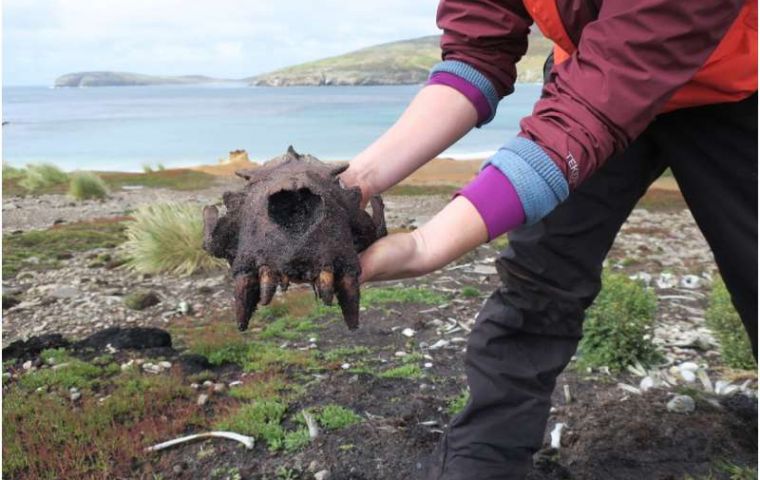MercoPress. South Atlantic News Agency
Falkland Islands: Team discovers evidence of prehistoric human activity
 Kit Hamley holds a large male sea lion skull from a bone pile at New Island
Kit Hamley holds a large male sea lion skull from a bone pile at New Island The following piece was published by Phys/Org – Since its first recorded sighting by European explorers in the 1600s, scientists and historians have believed that Europeans were the first people to ever set foot on the Falkland Islands. Findings from a new University of Maine-led study, however, suggests otherwise; that human activity on the islands predates European arrival by centuries.
Kit Hamley, National Science Foundation graduate research fellow with the UMaine Climate Change Institute, spearheaded the first-ever scientific investigation into prehistoric human presence on the Southern Atlantic archipelago. She and her team collected animal bones, charcaol records and other evidence from across the Iislands over multiple expeditions and examined them for indications of human activity using radiocarbon dating and other laboratory techniques.
One notable sign of pre-European human activity derived from a 8,000-year-old charcoal record collected from a column of peat on New Island, located in the southwestern edge of the territory. According to researchers, the record showed signs of a marked increase in fire activity in 150 C.E., then abrupt and significant spikes in 1410 C.E., and 1770 C.E., the latter of which corresponds with initial European settlement.
Researchers also gathered sea lion and penguin samples on New Island near the site where a landowner discovered a stone projectile point that is consistent with the technology Indigenous South Americans have used for the past 1,000 years. The bones were heaped in discrete piles at one site. Hamley says the location, volume and type of bones indicated that the mounds were likely assembled by humans.
Most of the evidence Hamley and her colleagues collected indicated that Indigenous South Americans likely traveled to the Falkland Islands between 1275 C.E. and 1420 C.E. Arrival dates prior to 1275 C.E., however, cannot be ruled out because some evidence dates back even earlier, according to researchers. For example, the team found a tooth from an extinct Falkland Islands fox called the warrah with a radiocarbon date of 3450 B.C.E., the oldest for the species. Regardless, all of the team's findings indicate that people landed in the archipelago before British navigator John Strong in 1690, the first European to set foot on the archipelago.
Indigenous people likely visited the Islands for multiple short-term stays, as opposed to long-term occupation, according to the UMaine researchers. As a result, they left few cultural materials there, but enough for Hamley and her colleagues to find a discernible anthropogenic and paleoecological footprint and conduct their study.
“These findings broaden our understanding of Indigenous movement and activity in the remote and harsh South Atlantic Ocean,” says Hamley, a UMaine Ph.D. student of ecology and environmental sciences. “This is really exciting because it opens up new doors for collaborating with descendant Indigenous communities to increase our understanding of past ecological changes throughout the region. People have long speculated that it was likely that Indigenous South Americans had reached the Falkland Islands, so it is really rewarding to get to play a role in helping bring that part of the past to life of the Islands.”
UMaine researchers who participated in the study with Hamley include her adviser, Jacquelyn Gill, an associate professor of paleoecology and plant ecology; Daniel Sandweiss, a professor of anthropology; and Brenda Hall, a professor of glacial geology.
Other investigators involved in the research include Dulcinea Groff, a postdoctoral research scientist at the University of Wyoming and former UMaine Ph.D. student; Kathryn Krasinski, an assistant professor of anthropology at Adelphi University; John Southon; a researcher with the Department of Earth System Science at the University of California-Irvine; Paul Brickle, executive director of the South Atlantic Environmental Research Institute; and Thomas Lowell, a geology professor with the University of Cincinnati.
Science Advances has published a report of their findings.




Top Comments
Disclaimer & comment rules-

-

-

Read all commentsVernet's great, great, great granddad?
Oct 28th, 2021 - 10:01 am +2An important reason for adopting BCE/CE is religious neutrality.
Oct 28th, 2021 - 07:44 pm +2A theory, certainly.
Oct 28th, 2021 - 10:52 pm +1Indigenous boats probably got out to the Islands the same way the first Europeans did - unintentionally, in a storm.
https://falklandstimeline.files.wordpress.com/2021/04/1480-to-1762.pdf
Commenting for this story is now closed.
If you have a Facebook account, become a fan and comment on our Facebook Page!